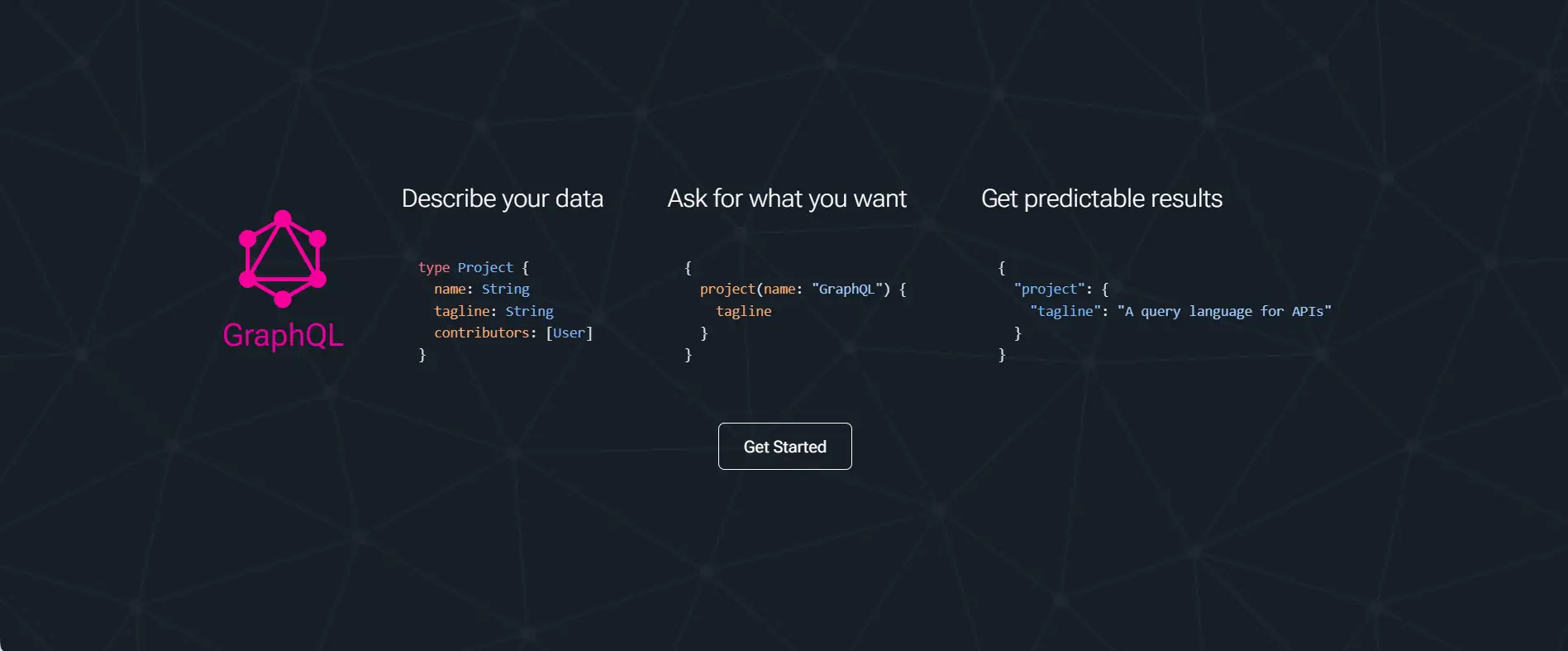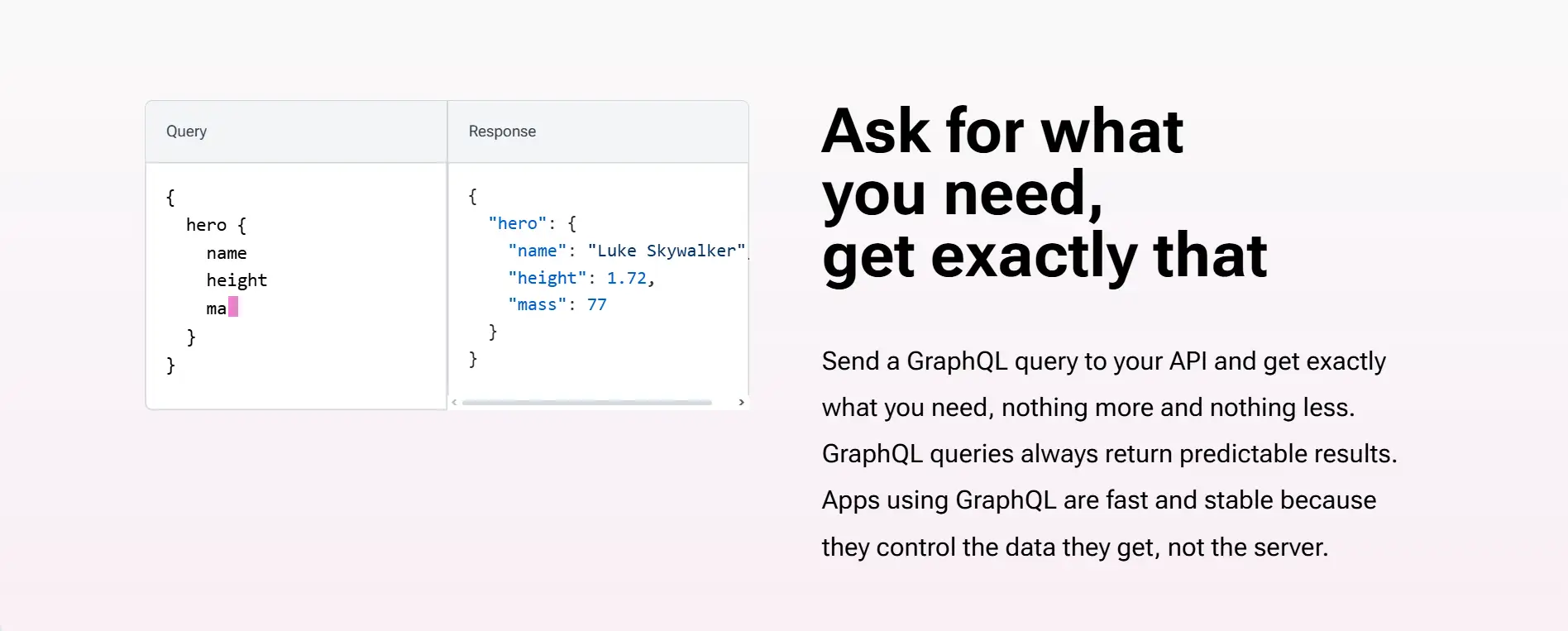About GraphQL
GraphQL is an open-source query language for APIs and a runtime for executing those queries with your existing data. Developed originally by Facebook in 2012 and open-sourced in 2015, GraphQL enables developers to request exactly the data they need—nothing more, nothing less—offering a more efficient, powerful, and flexible alternative to REST APIs.
By using a strongly-typed schema and a single endpoint to expose structured data, GraphQL empowers front-end developers to craft optimized queries and streamline data delivery. It's now maintained by the GraphQL Foundation and used by companies like Facebook, GitHub, Pinterest, Shopify, and Coursera. With rich support for many programming languages and a growing ecosystem of tools, GraphQL is an essential technology for modern web and mobile application development.
GraphQL provides a revolutionary approach to API design, moving away from the rigid structures of REST to a more client-driven model. At the heart of GraphQL is its powerful type system that defines the structure of the data, enabling clients to request exactly what they need via a single endpoint. Unlike REST, where multiple endpoints are needed for related data, GraphQL enables you to fetch deeply nested, related resources in one efficient request.
The query language is intuitive and mirrors the structure of the expected response, reducing over-fetching and under-fetching problems common in traditional APIs. Whether you’re fetching a user’s profile, posts, or friends in one go, GraphQL simplifies data retrieval and boosts application performance, especially on limited-bandwidth environments like mobile devices.
One of its key strengths is its ability to evolve APIs without versioning. You can add new fields and deprecate old ones while keeping backward compatibility, significantly reducing the friction associated with version upgrades. This approach also improves maintainability and scalability of APIs as your product evolves.
For developers, GraphQL offers a powerful tooling ecosystem including GraphiQL, code generation, linting tools, and editor integrations. Backend implementers provide resolvers—custom functions connected to your existing code and data sources—which GraphQL uses to return structured responses. It is completely data-source agnostic, meaning it can integrate with SQL/NoSQL databases, REST endpoints, caches, or custom logic layers.
Popular GraphQL server implementations exist in JavaScript, Python, Ruby, Java, C#, Go, and more—making it accessible regardless of your tech stack. Additionally, a variety of clients like Apollo, Relay, and urql help manage queries, caching, and subscriptions on the frontend. Compared to alternatives like REST or JSON:API, GraphQL offers a more structured, performant, and flexible experience across all layers of your application.
GraphQL offers a wide range of features and benefits that make it a compelling choice for modern API development:
- Efficient Data Fetching: Clients can request only the fields they need, reducing payload sizes and improving application performance.
- Single Endpoint Access: Fetch deeply nested and related data in a single query instead of making multiple REST calls.
- Strongly-Typed Schema: Define the shape of your data using GraphQL's type system, allowing introspection, validation, and auto-documentation.
- Backward-Compatible Evolution: Add new fields and deprecate outdated ones without breaking existing clients.
- Tooling Ecosystem: Leverage IDE integrations, auto-generated documentation, and query visualizers like GraphiQL.
- Language Agnostic: GraphQL is supported across many languages including JavaScript, Python, Java, Ruby, Go, C#, and more.
- Decoupled from Storage: It doesn't require a specific database or storage engine—use it with any existing infrastructure.
Getting started with GraphQL is beginner-friendly and well-supported through comprehensive documentation and an active community:
- Explore the Docs: Visit the official GraphQL documentation for concepts, tutorials, and API references.
- Try the Playground: Use interactive tools like SWAPI GraphQL to test and understand query patterns in real time.
- Set Up a Server: Choose a GraphQL server library for your language (e.g., Apollo Server, Graphene, Sangria, GraphQL Java) and define your schema and resolvers.
- Build a Schema: Create type definitions and write resolver functions that map to your data sources.
- Integrate a Client: Use tools like Apollo Client or Relay for frontend GraphQL integration, caching, and state management.
- Join the Community: Get involved through the GraphQL Community, attend GraphQLConf, or follow updates on the official blog.
- Start Small: You don’t have to migrate your entire backend. Use GraphQL to wrap existing REST APIs and expand gradually.
GraphQL FAQ
GraphQL improves mobile app performance by allowing clients to request exactly the data they need in a single HTTP request. This minimizes over-fetching and under-fetching, reducing bandwidth usage—critical on mobile networks. Additionally, apps can reduce the number of network round-trips by retrieving nested or related data in one query. This efficient data delivery is especially beneficial for users on limited connections or using low-power devices.
Yes, GraphQL and REST can work together in a hybrid architecture. A common pattern is to use GraphQL as a wrapper around existing REST APIs. This enables modern client flexibility while leveraging existing REST infrastructure. GraphQL resolvers can delegate data fetching to REST endpoints, progressively modernizing your backend without requiring a full rewrite.
GraphQL acts as a powerful aggregation layer in a microservices environment. Instead of clients calling multiple services individually, a GraphQL server can orchestrate calls across microservices and expose a unified API schema. This simplifies the frontend and centralizes business logic at the API layer, resulting in cleaner code and better scalability. Tools like Apollo Federation even allow teams to compose schemas from multiple microservices dynamically.
GraphQL uses a robust type system to define the structure of API data. Every field and argument must match its declared type, ensuring that clients send valid requests. The schema is also introspectable, enabling developer tools to perform real-time validation, autocomplete suggestions, and type-based documentation. Invalid queries are rejected with detailed error messages, reducing bugs and improving DX (developer experience).
Absolutely. While client libraries like Apollo Client and Relay offer enhanced features like caching and subscriptions, GraphQL can be queried using plain
fetch()or any HTTP client likeaxios. This lightweight approach is ideal for small apps or when adding GraphQL incrementally. You still benefit from predictable query responses and schema-driven development even without a specialized client.
You Might Also Like












